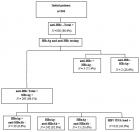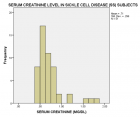Table of Contents
Strongyloides stercoralis and glomerular diseases: A case report
Published on: 3rd November, 2022
Strongyloidiasis is an intestinal parasitic infection caused by the nematode Strongyloides stercoralis. It is endemic in rural tropical and subtropical areas with a prevalence of 100 million people worldwide [1]. In Spain, we find endemic areas at several points on the Mediterranean coast [2].
Accidental placement of hemodialysis catheter tip in the right internal mammary vein: a case report
Published on: 5th October, 2022
OCLC Number/Unique Identifier: 9645193845
Hemodialysis catheter placement, particularly Internal Jugular Catheter insertion, is a very common procedure for patients who require urgent access to renal replacement therapy. Most of these procedures are done under ultrasound guidance as recommended by KDIGO 2019 vascular access guidelines. However, catheter tip misplacement can still occur even in the experts’ hands and despite the use of ultrasound. In this case report, we will discuss a hemodialysis catheter tip placement in the right internal mammary vein and how we managed it.
Medical mystery: Deposition of calcium oxalate and phosphate stones in soft tissues
Published on: 30th September, 2022
OCLC Number/Unique Identifier: 9639226630
Calcinosis cutis (CC) [1] is an unusual disorder characterized by calcium-phosphate deposition into cutaneous and subcutaneous tissues. There are five subtypes: dystrophic, metastatic, idiopathic, iatrogenic and calciphylaxis.Calciphylaxis or calcifying panniculitis is defined as small vessel calcification mainly affecting blood vessels of the dermis and subcutaneous fat. Despite the predominance of cases in patients with ESRD, calciphylaxis can also be found in patients with normal renal function and normal levels of calcium and phosphate. These cases are often referred to as nonuremic calciphylaxis (NUC), a heterogeneous category with several associations. Literature reveals an association with hyperparathyroidism (28%), malignancy (22%), alcoholic liver disease (17%) and connective tissue diseases (11%) while obesity, liver disease, high-serum calcium (Ca) × phosphorus (P) levels, combined therapies of calcium salts with vitamin D, warfarin and corticosteroids have been observed to increase the likelihood of this disease [2]. The lesions in both nonuremic and uremic calciphylaxis tend to be indistinguishable from each other, initially presenting as tender subcutaneous plaques that progress into nonhealing ulcers with overlying black eschar. Skin changes often begin with a livedo reticularis pattern that can progress to livedo racemes and ultimately retiform purpura.In our clinical case, we describe a patient with multiple risk factors for calciphylaxis, intense widespread calcification (vessels, tendons, joints) and cutaneous calcific stone of calcium and phosphate oxalate not elsewhere described before.
Comparison of GFR measurement with [99mTc]-DTPA and clinical methods based on creatinine measurement, in patients over 80 years old
Published on: 28th September, 2022
OCLC Number/Unique Identifier: 9638982949
Introduction and aim: The most accurate way of measuring kidney function in GFR. Clinical formulas based on creatinine measurement may be inaccurate mainly in elderly patients (over 80 years of age). In this study we evaluated the accuracy of commonly used clinical formulas by comparing them with a direct measurement with [99mTc]-DTPA ([99mTc]-diethylene-triamine-peracetic acid) in a population of patients aged eighty and older.Material and methods: 47 patients (27 males and 20 females) with an average age of 81.9 ± 1.7 years, 80% already diagnosed with Chronic Kidney Disease (CKD), were investigated. Two plasma samples were collected between 60-90 and 165-190 minutes after the injection of [99mTc]-DTPA and GFR were calculated. Results: When comparing the GFR values obtained from the various formulae by creatinine levels with the GFR value obtained by measuring [99mTc]-DTPA residue, the following concordance values emerged: (1) MDRD: 55.3%, (2) Cockroft-Gault 55.3% (3) CKD-EPI 57.5% (4) BIS-1 51.1%Conclusion: Our data show a poor correlation between all clinical methods and [99mTc]-DTPA, which remains a gold standard for the direct measurement of GFR.
An unusual case of corynebacterium gleum peritonitis in peritoneal dialysis
Published on: 20th September, 2022
OCLC Number/Unique Identifier: 9625092361
Peritonitis is a common and serious complication of Peritoneal Dialysis (PD) and its prevention and treatment are very important to reduce patient morbility and mortality. PD-related peritonitis can be caused by many germs; in most cases Gram-Positive Cocci (GPC) are responsible. In our report instead, we present the first case, to our knowledge, of peritonitis due to Chryseobacteriumgleum in a peritoneal dialysis patient.Our aim is to make known this type of opportunistic pathogen that can survive in a hospital environment so as to prevent C.gleum-related peritonitis. The rapid identification of this pathogen in the laboratory is very important for guiding therapy and preventing further complications.
Administration of G-CSF for PBSC collection may unmask pre-existing IgA-nephropathy: A case report
Published on: 14th September, 2022
OCLC Number/Unique Identifier: 9625089266
It is utterly important to ensure the safety of stem cell donors and limit the incidence of long-term adverse events. Additionally, the willingness to donate the potentially life-saving stem cells, depends among other reasons, on the donor’s trust in the safety of the procedure as our case highlights. Here we present the case of a 35-year-old patient who developed macrohematuria and proteinuria following peripheral blood stem cell (PBSC) donation. 4 years later he was diagnosed with IgA-nephropathy (IgAN) and the disorder was causally attributed to the PBSC donation. He discouraged his family and friends from registering as donors because of this. In the current case report, we review the literature on the relationship between IgAN and PBSC donation and suggest under which conditions stem cell donation can still be performed even with a prior diagnosis of IgAN.

HSPI: We're glad you're here. Please click "create a new Query" if you are a new visitor to our website and need further information from us.
If you are already a member of our network and need to keep track of any developments regarding a question you have already submitted, click "take me to my Query."


























































































































































